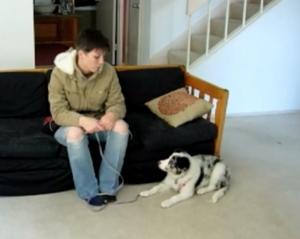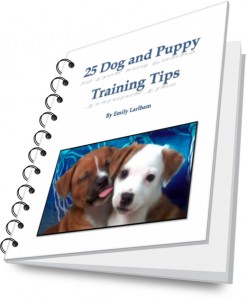By Emily Larlham
Perhaps you adopted a puppy from another home where he was kept only outside, or perhaps you yourself have decided to keep your dog inside the house from now on. A very normal response for a puppy or even an adult dog who has never or rarely been in a house is to become overexcited and want to interact with and jump on everything. Just entering the house can make your dog to want to run around madly and chew on everything in sight.
There are many benefits to having your dog live with you inside the house. First of all, doing so keeps your dog safe from being harmed by the outside environment, and from being scared by strange sights and sounds. Also, dogs that are kept inside are more likely to ward off thieves and criminals. Think about it: if the dog is outside, a criminal can easily poison or injure him from behind the fence and then break into your house once he is out of the picture. Sadly, this very thing happened to one of my best friend’s dogs, and help came too late to save the dog’s life. Dogs can also be stolen from your back yard. If you wouldn’t leave your expensive computer in your yard when you are gone, then you probably shouldn’t leave your dog in the yard in that same neighborhood.
To train a dog that has never been in a house to be calm, first you can walk him through the living room and areas in which you want him to be loose in the future. Use a leash and harness, feeding him for simply walking with you calmly. As your puppy is looking around at his new world, pop a treat in his mouth for “doing nothing.” You don’t want to click as this could excite your dog and make him think you are doing a training session and want him to offer behaviors. What you want to do is pop a treat in your dog’s mouth or drop a treat between your dog’s paws for calmly looking around and doing absolutely nothing. If he lunges at anything, prevent him by not giving him enough leash to reach whatever it is he was interested in.
Once your dog is familiar with being inside the house, you can start working on teaching him to settle on leash. You need to teach this behavior because just hoping for the best and letting your dog inside off leash could cause both you and him lots of grief. Dogs can only offer dog behaviors, and most dogs who have never been inside will likely offer behaviors most people don’t like. By teaching the dog that settling and being calm inside is the best option, you will be setting your dog up for a successful future of hanging out with you indoors.

This video goes over the steps of capturing calmness and how to teach a settle:
http://www.youtube.com/watch?v=wesm2OpE_2c
First, if your dog is calmer outside, practice the settle within these familiar surroundings where your dog can succeed more rapidly. Then practice inside. Finally, practice having your dog settle in different parts of the house. You can choose to have him settle in different dog beds conveniently placed around the house, so that seeing the dog beds in the future will entice him to want to lie down in them. You can also tether him (to something secure) with a leash and harness and practice having your dog settle while you are further away, but still inside the house. Always supervise your dog when tethered to prevent accidents from happening. For example, your dog getting tangled or chewing through the leash and harness.
In conjunction with this training, you can teach your dog the “positive interrupter”: an attention noise that means “stop doing what you are doing and look at me” (see the video below for how to train this). You can also teach your dog the cue “Leave it” (see the video below on how to train this behavior). The final step is letting your dog off leash in the house under supervision. Reinforce calm, relaxed behaviors and interrupt overexcited or otherwise undesirable behaviors with the already-trained attention noise or “Leave it” cue. If you are really worried your dog will not listen to you off leash in the house, you can have your dog drag a long line attached to his harness, when first given freedom in the house. So, if your dog doesn’t listen to you, you can pick up the other end of the leash. This will prevent your dog from learning that it’s fun to run away from you in the house with things you don’t want your dog to have.
How to teach the positive interrupter noise to interrupt unwanted behavior:
http://www.youtube.com/watch?v=TBvPaqMZyo8
How to teach the “Leave it” cue:
http://www.youtube.com/watch?v=pEeS2dPpPtA
 25 Dog and Puppy Training Tips:
25 Dog and Puppy Training Tips:
For each month of the year, I will release 2 training tips that will be accessible for free at dogmantics.com. If you simply cannot wait for the information to be published online, you can buy the collection of all 25 training tips in an ebook format here: 25 Dog and Puppy Training Tips
This is a list of all the tips included in the ebook, and that will be eventually available online:
- Teaching a dog previously kept outside to be calm inside the house
- The problem with ignoring unwanted behaviors
- Fading a lure
- Adding a verbal cue or changing a cue
- Dogs and babies
- Socializing tips- Our world can be a scary place!
- What to do if your puppy bites you OUTSIDE of a training session
- Changing your thinking from “I don’t like” to “I need to work on”
- What to use as reinforcement
- Treat deliveries
- Teaching your puppy appropriate greetings on leash
- Teaching “All done” for training sessions and dinnertime manners
- Variety is the spice of life… and training!
- Teaching your puppy to walk off leash
- Don’t let your dog free feed
- Don’t only work on one behavior at a time
- Separation training tips
- Monkey see, monkey do- Take advantage of social facilitation
- Always remember to release your dog!
- The importance of handling
- Chewing
- Teaching “Drop” and “Get it”
- What to do if your puppy sits and refuses to budge on a walk
- Generalizing
- Training your dog to do absolutely… NOTHING!
